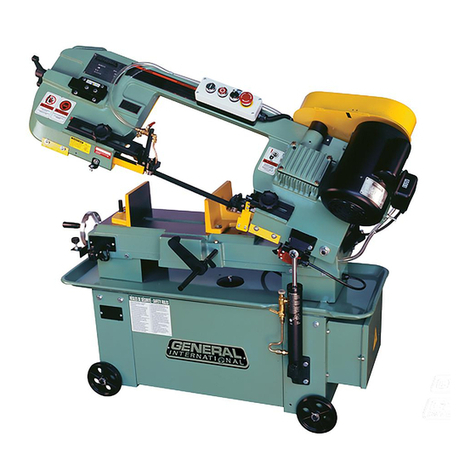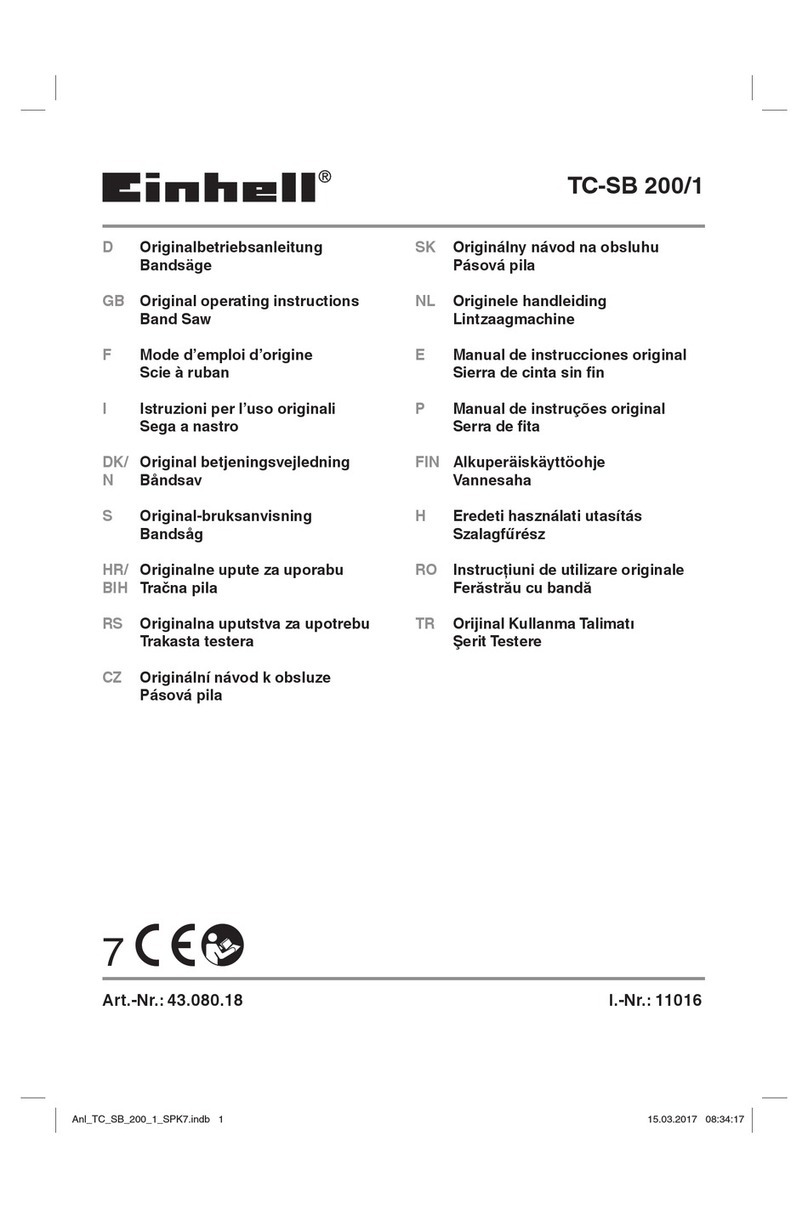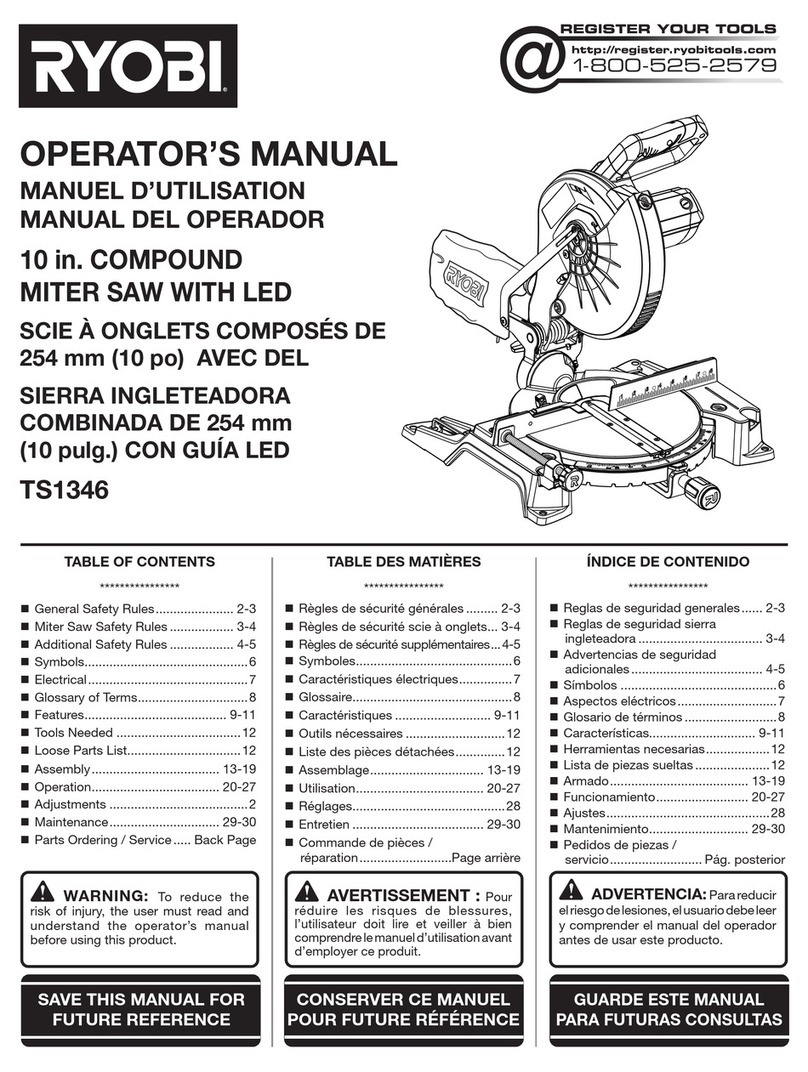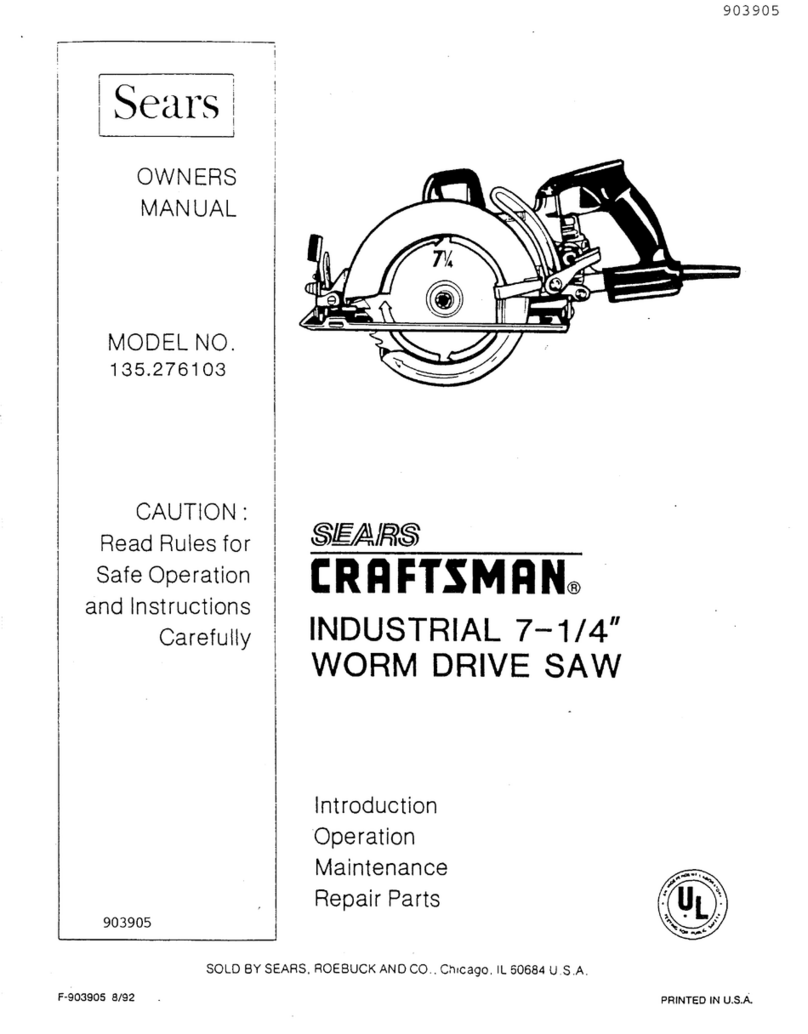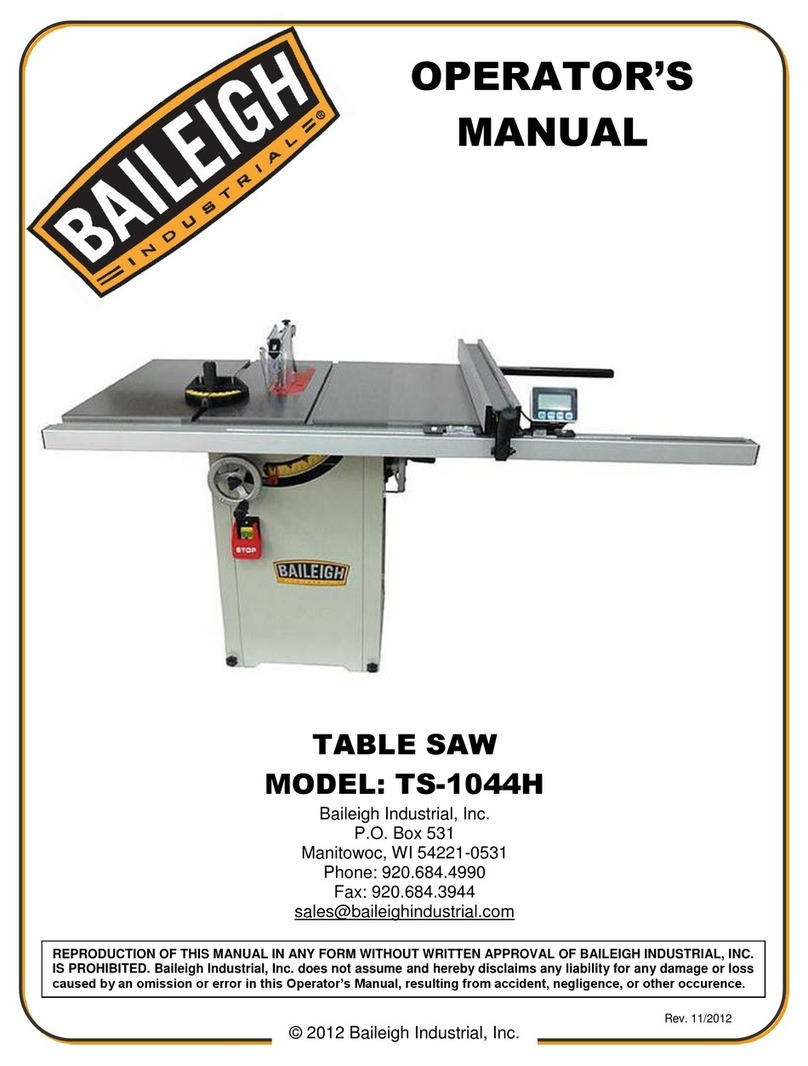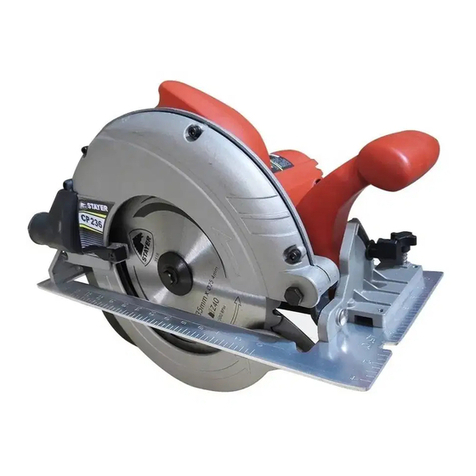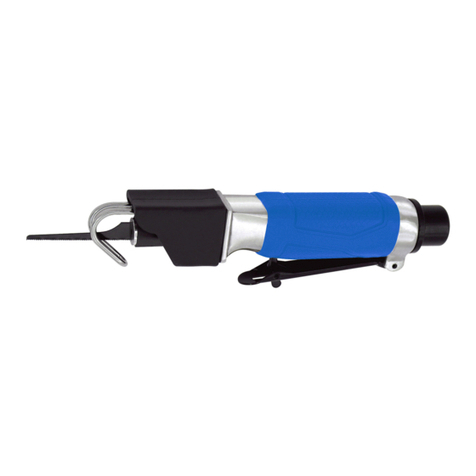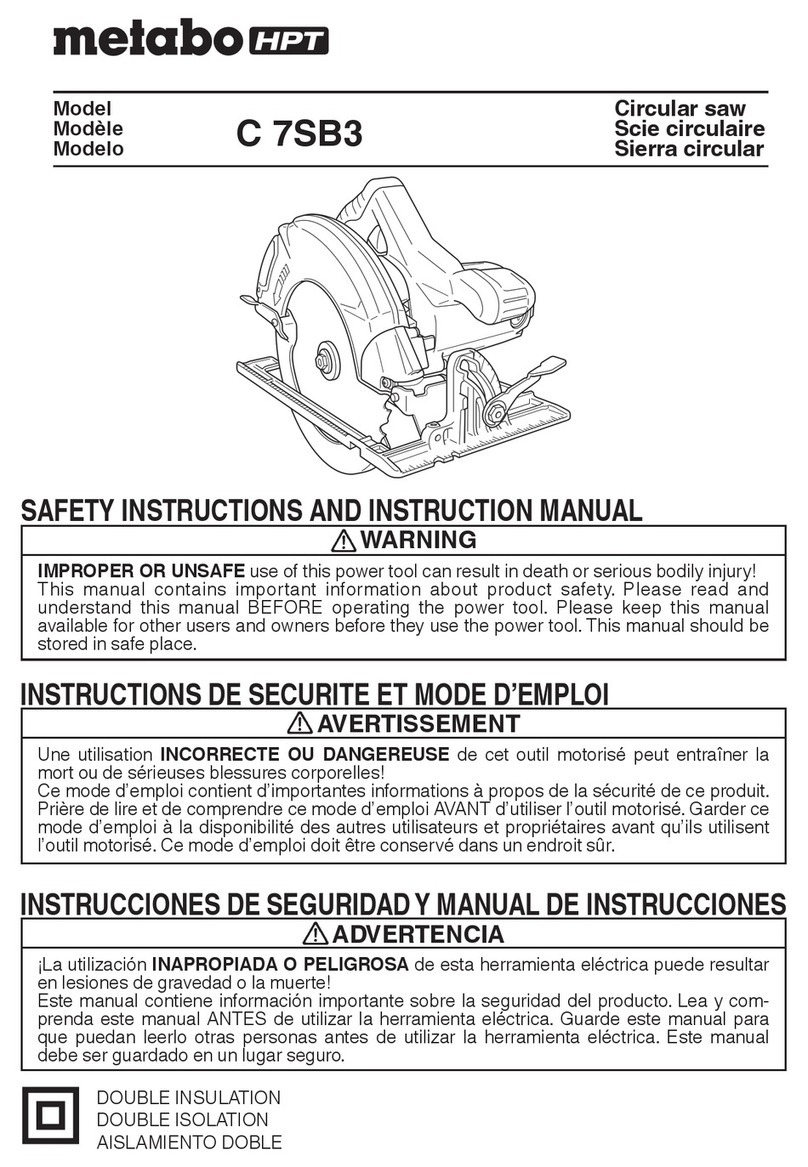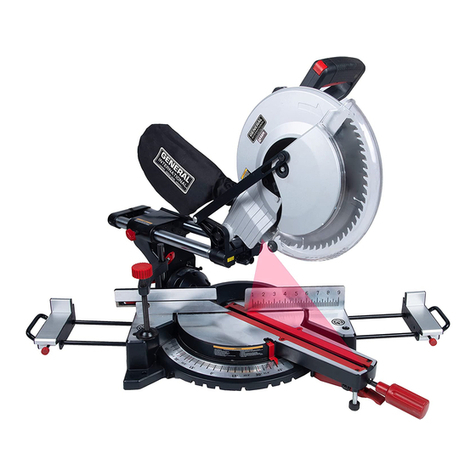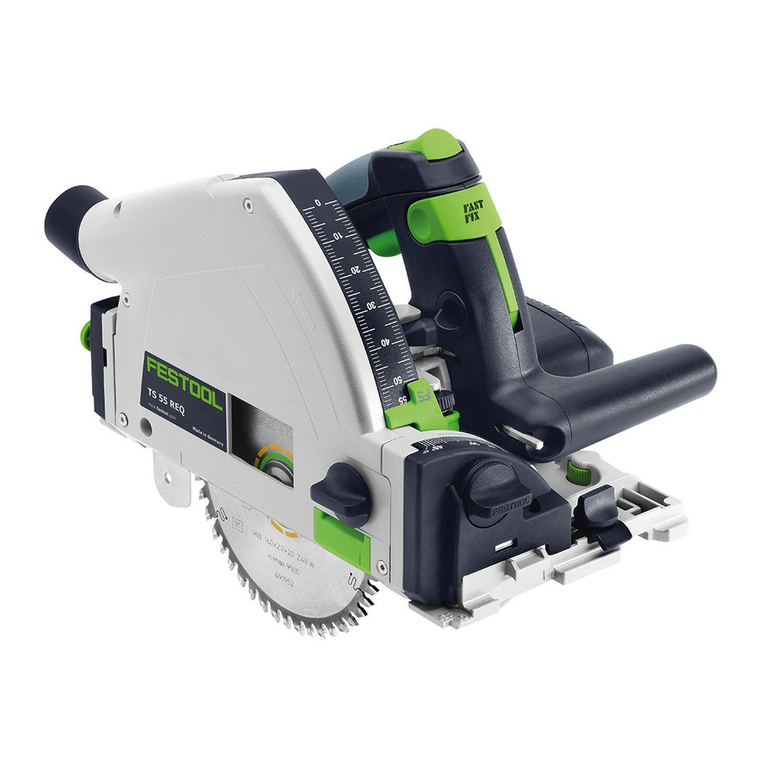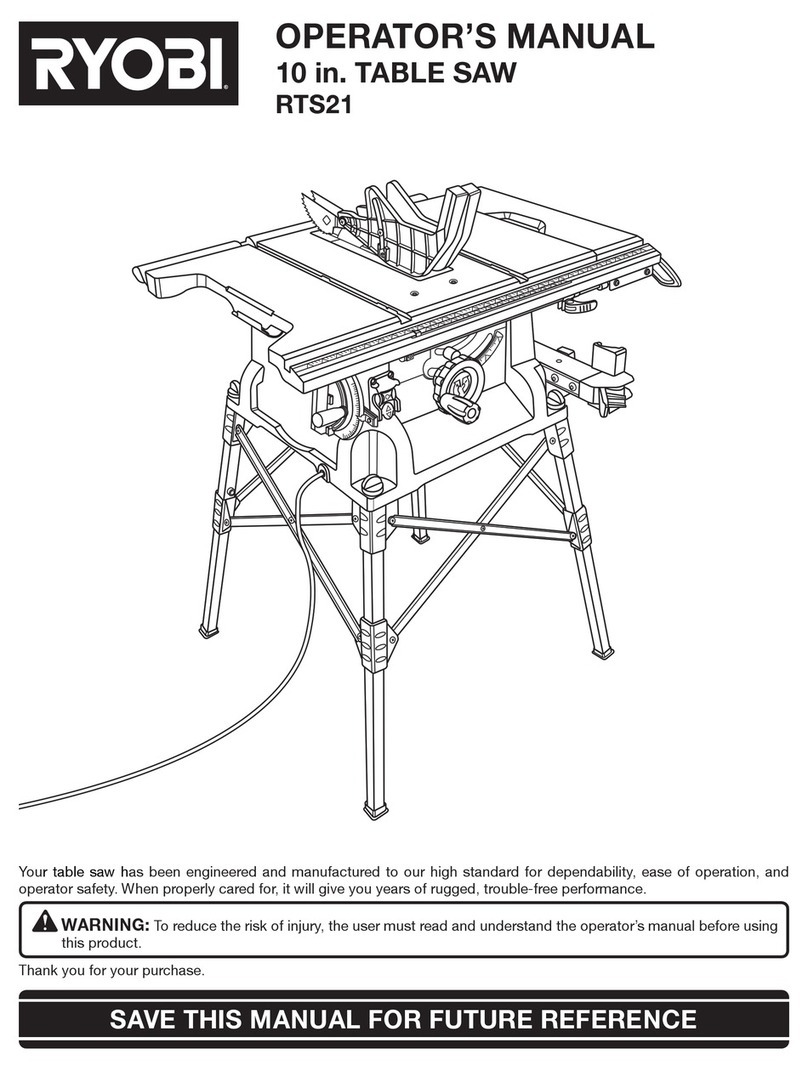Belmash SDM-2000 User manual

1

2
CONTENTS
1. Declaration of conformity ЕС/ЕЕА 3
2. Intended use 4
3. General information 4
4. Main parameters 5
5. List of standard equipment 6
6. Basic components 7
7. Machine structure 12
8. Safety issues 13
9. Marking and packing 16
10. Setting-up procedures 17
11. Basic operations 22
12. Maintenance and repair 30
13. Troubleshooting 32
14. Storage 33
15. Transportation 33
16. Disposal 33
Warranty certificate 34
Acceptance certificate 36

3
This operating manual establishes machine service instructions and rules of safe operation.
Please read all instructions contained in this operating manual before using the machine.
The woodworking machines, if not operated safely, may endanger human life and health.
Hazardous exposure: noise, vibration, dust and cutting wastes, electricity.
Compliance with the requirements, specified in the operating manual, ensures safety while in
use and helps to avoid problems during operation and maintenance.
This operating manual does not reflects slight changes and modifications in machines, made
by the manufacturer after the publication of this manual, as well as changes in component
details and documentation attached to it.
1. DECLARATION OF CONFORMITY ЕС/ЕЕА
Joint limited liability company “Zavod Belmash” declares that multifunctional woodworking
machines
BELMASH SDM-2000
BELMASH SDM-2200
BELMASH SDM-2500
comply with the following requirements of EU Directives, including changes:
2006/42/EC Machinery (MD)
2004/108/EC Electromagnetic Compatibility (EMC)
2011/65/EURO HS Directive
A basis for concordance of the mentioned above devices with the EU Directives is their full
compliance with the applicable standards listed below:
EN 61029-1: 2009 + A11: 2011
EN 62233: 2008 (incl. Corr: 2008)
EN 55014-1: 2006 + A1: 2009
EN 55014-2: 1997 + A1: 2001+A2: 2008
EN 61000-3-2: 2006 + A1:2009+A2: 2009
EN 61000-3-3: 2008*
EN 61000-3-11: 2010**
01/222-1*
01/222-2**
_____________________________________________
* - for machines BELMASH SDM-2000
** - for machines BELMAS SDM-2200, BELMASH SDM-2500
Director _____________ D. V. Shorikov
Conformity certificates are stored at the address:
Zavod Belmash JLLC, Slavgorodskiy Proezd, 37 Republic of Belarus, 212000, Mogilev.

4
2. INTENDED USE
The machine relates to equipment for the domestic individual use.
The hand-fed machines are used for processing of wood and analogous hard materials
(cardboard, plywood, wood chip boards) by planing, cutting, milling and drilling in order to
give them the required shapes and sizes.
Do not use the machine for other purposes. It is not allowed to process metals, stone,
asbestos-cement materials, soft plastic and rubberlike materials
With appropriate adjustment the machine can perform the following types of processing:
planing (jointing) on surface or along ribs;
angular planing (jointing, along ribs);
longitudinal and cross cutting;
longitudinal angular cutting with the use of a ruler;
angular cross cutting with the use of device;
milling with disc cutters;
milling with end cutters;
drilling.
3. GENERAL INFORMATION
The machine can be operated outdoors, under cover, indoors, except for residential premises.
Climatic service conditions:
altitude above the sea level – up to 1000 m;
environment temperature from +5 to +40°С;
environmental relative humidity – up to 80%, at a temperature of +20°С.
It is not allowed to operate the machine under the impact of drops and splashes, as well as
outdoors during rain, fog, snowfall, strong wing, and storm.
The power of the machine is supplied by a single-phase AC with an earthed positive earth.
BELMASH SDM-2200 и BELMASH SDM-2500 machines shall be used in the electrical grids
with a nominal impedance zmax=0,354 ohm. The user must agree on the rated load capacity
sufficient for the mentioned above machines with Electric Inspection Service.
Type of engine – asynchronous, single-phase, with the working capacitor, intermittent
operating status – S6-40%.
The equivalent and maximum sound levels are as follows: 80 dBA and 90 dBA relatively.
The machine has a built-in disconnect device from the power supply during asynchronous
engine overheating. Restarting of the machine can be performed after the electric motor has
cooled down to the ambient temperature.
To connect the external exhaust units in order to collect dust and cutting wastes, the
woodworking machine has three pipes:
a pipe with 63 mm in diameter on casing for chip removing 24 (Fig. А);
a pipe with 38 mm in diameter on casing of saw blade 30 (Fig. А);
a pipe with 28 mm in diameter on fencing of saw blade 29 (Fig. А).
The external exhaust unit should be suitable for removing cutting wastes.

5
4. MAIN PARAMETERS
Main parameters are specified in the Table 1.
Table 1
№ Name
Parameters
BELMASH
SDM-2000
BELMASH
SDM-2200
BELMASH
SDM-2500
1 Max. planing width per pass, mm 230 250 270
2 Range of planing depth per pass, mm 0÷3 0÷3 0÷3
3 Max. height of the work piece pressed by a holding
down device, up to, mm 65 65 65
4 Max. uncut dimensions, length×width×height
(depth), mm 2000×230×85 2000×250×100 2000×270×117
5 Range of cutting depth, mm 0÷85 0÷100 0÷117
6 Range of cutting depth per pass, mm 250 280 315
7 Diameter of disc cutter 125 125 125
8 Diameter of mounting bore of disc cutter/ saw
blade, mm 32 32 32
8 Diameter of end cutter, mm 612 612 612
9 Range of longitudinal cutting angles and planing
with the use of a ruler, degrees 0÷45 0÷45 0÷45
10 Range of cross cutting angles with the use of a
device, degrees –45÷45 –45÷45 –45÷45
11 Cutting table dimensions, mm 732×456 802×492 872×532
12 Dimensions of tables during planing, mm 760×247 830×267 900×287
13 Milling table dimensions, mm 470×190 470×190 470×190
14 Rated idle RPM of a knife’s block and end cutter,
min-1 7700 7700 7700
15 Rated idle RPM of a saw blade and disc cutter, min-1 2850 2850 2850
16 Rated consumed power, W 2000 2200 2500
17 Rated frequency, Hz 230 230 230
18 Rated frequency, Hz 50 50 50
19 Overall dimensions, L×B×H, mm 806×793×445 876×829×460 949×849×512
20 Setting dimension, L1×B1 (min. the size of the site
for the installation of the machine), mm 430×206 430×226 441×246
21 Weight of machine including devices (net/gross), kg 52,4/55,3 56,1/59,2 61,3/64,9
Limit deviations of linear and angular dimensions do not exceed ±5%
Limit deviation of the rotating frequency does not exceed ±5%
Limit deviation of the power consumption +15%

6
5. LIST OF STANDARD EQUIPMENT
Table 2
№ Item Name
Quantity, pсs
BELMAS
SDM-2000
BELMASH
SDM-2200
BELMASH
SDM-2500
Devices, tools, fencing
1 - Portable multifunctional woodworking
machine 1 1 1
2 28, 29 Fencing of saw blade and disc cutter
together with the splitting knife 1 1 1
3 11, 12 Angular bump as a set with a ruler 1 1 1
4 34 Device for angular cross cutting 1 1 1
5 41-44 Vertical holder 1 1 1
6 56 Chuck screw wrench 1 1 1
7 68 Hook wrench 1 1 1
8 7 Knife’s block fencing 1 1 1
9 8 Bracket 1 1 1
10 46 Milling table 1 1 1
11 51 End mill fencing 1 1 1
12 45 Insert for milling 1 1 1
13 24 Casing 1 1 1
14 22
74
75
76
77
78
79
23
80
81
23а
Holding down device
Spring box
Right support
Left support
Rotation axis
Clamp axis
Clamp handle
Screw М5×12
Screw nut М8
Spring washer 5
Spring washer 8
1
1
1
1
1
1
1
4
2
4
2
1
1
1
1
1
1
1
4
2
4
2
1
1
1
1
1
1
1
4
2
4
2
15 - Pusher 1 1 1
Standard articles
16** 25 Circular saw blade 1 1 1
17 55 Drilling chuck 13-М12×1,25 1 1 1
18** - Fixing arrangements 1 set 1 set 1 set
19 - Hex key 1 1 1
Documentation
20 - Operating manual 1 1 1
21 - Warranty certificate 1 1 1
Personal protective equipment
22 - Earplugs 1 set 1 set 1 set
23 - Protective goggles 1 1 1
24 - Mask 1 1 1
** –Fixing arrangements can be installed on the machine or its tools and devices

7
6. BASIC COMPONENTS
Fig. A
Planing function
1 – Knife block
2 – Loading table
3 – Outfeed table
7 – Knife’s block fencing
8 – Swing bracket for knife’s block fencing
9 – Clip for fixing of knife’s block fencing
10 – Flywheel for clip fixing
11 – Angular bump (vertical)
12 – Gib stick of angular bump (vertical)
13 – Cutting/planing angle scale (vertical)
16 – Flywheels for angular bump fixation (vertical)
17 – Flywheels for cutting/planning angle fixation (vertical)
18 – Swivel control panel
20 – Safety switch cover
21 – Flywheel for control panel fixation
11
13
16
17 21
20
18
12 1
10 9 7
8
2
3

8
Fig. В1, B2
Cutting function
12 – Gib stick of angular bump (vertical)
24 – Pipe for cutting wastes
25 – Saw blade
26 – Cutting table
27 – Stick for lifting and lowering of saw blade
28 – Splitting knife
29 – Fencing of saw blade / disc cutter above the table
level
30 – Fencing of saw blade / disc cutter below the table
level
31 – Cutting table mounting
32 – Flywheel for fixation of saw blade / disc cutter
33 – Hold slide for angular cross cutting
34 – Device for angular cross cutting
35 – Angular cross cutting scale
36 – Flywheel for bum fixation
37 – Cutting depth scale
38 – Depth scale of milling with disc cutter
39 – Tool-slide indicating cutting/milling depth
40 – Disc cutter (not included in the scope
of delivery)
45 – Insert for cutter guard below the tale level
56 – Box wrench
59 – Screw nut for splitting knife fixation
60 – Washer lock for splitting knife
67 – Screw nut for saw blade/ disc cutter fixation
68 – Hook wrench
59
24
27
31 28 25
60 30
37
38
33
36353429 12
26
32
39
25 67 67 40 45 32
32 68
56
В1
B2

9
Fig. С
Milling with disc cutter
11 – Angular bump (vertical)
12 – Gib stick of angular bump (vertical)
27 – Stick for lifting and lowering of saw blade
29 – Fencing of saw blade / disc cutter above the table level
41 – Vertical rod for fencing of disc cutter
42 – Horizontal rod for fencing of cutter
43 – Flywheel for vertical rod fixing
44 – Flywheel for horizontal rod fixing
42
27
41
44
43 12
11
29

10
Fig. D
End milling function
11 – Angular bump (vertical)
12 – Gib stick of angular bump (vertical)
16 – Fixing handwheels of angular support (vertical)
46 – Milling table
47 – End milling cutter (not included in the scope of delivery)
48 – Brackets for cutter accessory
49 – Lever-stick for lifting/lowering/of milling table
50 – Flywheels for fixation of cutter accessory
51 – Fencing of end milling cutter
52 – Lock bracket for operating mode disabler
53 – Rod for operating mode disabler
54 – Fixing screws for brackets of cutter accessory
55 – Drill chuck
58 – Wrench for drill chuck
64 – Fixing screws for end mill fencing 51/knife’s end block fencing 65
54
52
53 51
12
16
64 55
58
47
11
48 50 46 49

11
Fig. Е
Planing with holding down device
4 – Lever-stick for lifting and lowering the loading table and transferring the machine
5 – Lever-stick for lifting and lowering the outfeed table and transfer machine
6 – Flywheels for fixing loading and outfeed tables
14 – Planing depth scale
15 – Loading table scale
19 – Handwheel for fixing bracket 8
22 – Holding down device
23 – Fixing screws for holding down device
24 – Pipe for cutting wastes
61 – Washer locks for swing bracket of knife’s block fencing
62 – Lock ring for swing bracket of knife’s block fencing
63 – Axis for bracket 8
64 – Fixing screws for end mill fencing 51/knife’s end block fencing 65
65 – Knife’s end block fencing
66 – Fixing screws for cutting wastes pipe 24
6
62
22 66 6
63
14
4
61 19 23 64 65
15
5
24

12
7. MACHINE STRUCTURE
The machine is an electromechanical device. The woodworking machines are powered with
the help of asynchronous electromotor. Rotation from the motor to the knife block (outlet
end of the knife block) and saw blade is performed with the help of multiple vee belt drive.
The belt covers driving pulley and two driven pulleys. The first of the driven pulleys generates
the rotation of the saw blade, and the other one generates the rotation of the knife block and
the end mill cutter. The belt tension is performed automatically as a result of the
electromotor and traction coil weight.
The woodworking machines are equipped with the interlocking devices, which allow
performing only one type of processing: cutting/milling with disc cutter or planning/milling
with end mill cutter.
The machine has a stationary table for cutting and two replaceable tables for planning
(outfeed and loading tables). Planing tables, when used in cutting mode, complement cutting
table.
In the planning mode, the loading and outfeed tables are mounted at the level of slicing
blade cut. Besides, the front table can move down below the level of the slicing blade cut.
That provides the necessary planning depth.
In the cutting mode, the planning tables are mounted at the level of cutting tables, forming a
single-piece area of cutting table. In this case, planning tables cover the rotating cutter block,
ensuring safe operating. Displacing of tables is performed with the help of the in-built lever-
sticks. Such a construction helps to easily and quickly readjust the machine to the necessary
type of processing.
Machine stop has special protection from spontaneous shutdown. It is installed on the
mobile bracket, rotating to ensure accessible switch-on/switch-off of the machine.
The tables serve as a basic supporting surface for a workpiece.
The machine has an angular bump with a ruler and a device for angular cross cutting to
ensure the right location of the workpiece to a cutting tool and the forward, straight,
longitudinal motion.
In order to avoid saw blade jamming during cutting, there is a splitting knife in the machine
construction.
The woodworking machine is equipped with protection devices to prevent access to rotating
parts of the device.
The design includes portable hinged guard to prevent access to the cutter block.
To prevent access to a saw blade /disk cutter, stationary fencing is located below the cutting
table and movable fencing – above.
The design includes end mill fencing to prevent access to end mill/drill.
To prevent access to the end of the rotating cutter block (while the milling device is not
operated) – stationary protection device – end mill fencing.
The machine is equipped with measuring scales, indicating the cutting depth, milling with
disc cutters and planning depth.

13
8. SAFETY ISSUES
Before starting to use the machine the user shall take into account his physical state,
qualification and complexity of tasks. Persons operating the woodworking machines must be
at least 18 years of age and must study the operating manual.
IT IS FORBIDDEN:
to work under the influence of alcohol or other intoxicating substances;
to expose the machine to dripping and splashing, as well as using it outdoors during rain
and snowfall;
to leave the machine unattended while it is connected to the supply mains;
to provide access to the machine to people, who do not have any professional knowledge
in this sphere;
to use the machine for purposes other than that intended;
to process metals, stones, asbestos-cement materials, soft plastic and rubberlike materials.
IT IS FORBIDDEN to use the machine if any of the following problems occur during its
performance:
damage of plug-and-socket connection, power cord;
damage of ground circuit;
if you smell fume or odor, typically occurring during burning insulation;
failing operation of the switcher;
formation of loud noise, hammering, vibration;
damage or cracks in the basic parts, fencings, casings.
The machine must be disconnected using the switch in case of spontaneous stop (during
rotating parts jamming, etc.). Always place the appropriate cover over the switch during work
breaks.
When connecting the machine it is recommended to use automatic safety fuse or fuse with a
rated current equal to 16А.
Use the plug to disconnect the machine from the supply system:
while changing the working tool (disc cutter, knifes, etc.), installing accessories or
adjusting;
while transferring the machine from one working place to another;
during work breaks, when the work is completed;
during technical maintenance;
while removing cutting wastes.
Power cord of the machine must be protected from accidental damage (it is recommended
to hang it). Direct contact of the electrical cord with hot and oily surfaces is forbidden.
While working outdoors it is permitted to use the original, appropriately marked extension
cord.
Always make sure that the workpiece does not contain nails or foreign objects.
When processing short and narrow pieces use a secure workpiece infeed (paragr. 8.6).
Do not wear too loose clothing and jewelry. They can get to the moving parts of the machine.
When working outdoors it is recommended to use gloves and slip-resistant footwear. Wear
appropriate personal protective equipment and head covering.

14
To ensure high-quality and safe operation, the cutting part of the working tool must be sharp
and clean. Follow the instructions to replace the accessories.
8.1 Workplace requirements
The workplace should be determined taking into account the location of the workpieces ,
direction of their movement, and junkyard location;
Space around the entire perimeter of the working tables should be empty. Working
clearance is necessary for direction, infeeding and unloading of workpieces taking into
account their overall dimensions and weight;
The floor must not be slippery or have any obstacles;
Keep the machine and workplace clean;
The workplace should be well lit by natural sunlight or artificial light. Using fluorescent
lighting causes stroboscopic effect that may lead to incorrect identification of rotating
direction of moving machine parts;
Ensure proper ventilation when working indoors, for example, with the help of air vent or
by proving air supply;
Do not work in the rooms with explosive or chemical environments;
Comply with safety regulations when working indoors. A fire extinguisher is a must.
8.2 Additional safety measures
Keep children and unnecessary persons away from a working area;
Ensure you always have a firm and safe footing. Do not attempt to reach the object that
are out of distance;
When working avoid contact with grounded devices (for example: pipelines, electric
cookers, refrigerators );
Do not stand in the area of the plane of saw blades. Keep to the left or to the right side
from them;
Please attend, mind what you do, do not use the machine when tired;
Do not use damaged or distorted saw blades and knives;
Use the saw blades, knives, cutters and equipment, recommended by the manufacturer;
Notice that the choice of the saw blade depends on the work material;
Use the splitting knife and adjust it in the appropriate manner;
Use head guard (casing) of the saw blade and adjust its location appropriately;
Do not overload the machine;
Do not process too small and too short workpieces;
Replace the plastic insert of the saw blade when it is worn out.
8.3 Operational hazards
The following types of hazards may appear even if the machine operates properly:
Risk of injury from a flown away workpiece;
Risk of injury from breaking parts of the workpiece;
Risk of noise and dust;
Danger of electric shock due to improper laying of the power cord.
To reduce the noise impact, when operating at the machine, always wear personal protection
equipment to prevent hearing damage (earplugs). It is recommended to use a dust mask to
protect the respiratory tract from dust particles.

15
The figures of equivalent and ceiling sound level (p. 3) are the levels of radiations but are not
necessarily the safe operating levels. Despite there is a correlation between levels of radiation
and noise impact, they can be reliably used to determine if further protection measures will
be required.
Factors that influence on the actual level of noise impact on the user include not only the
characteristics of working space (open air, under cover, enclosed space and its sizes), but also
other noise sources, namely, the noise from the other related processes. This information
allows the user of the machine to make a risk assessment and take care of the necessary
safety precautions.
Precautionary measures herein refer to the reducing of the noise dose by cutting time spent
in the work area, using of individual protective equipment such as earplugs, hearing
protectors, etc.
Allow only qualified persons to inspect and service the machine and use only original spare
parts.
8.4 Workpiece requirements
The workpiece weight must not exceed 50 kg.
The maximum workpiece dimensions are listed in Table 1. When processing workpieces of
greater length, it is necessary to use special trays that should be installed under the hanging
end of the workpiece, or work in a pair with someone. The minimum height of the workpiece
during planing or sawing should be not less than 5 mm.
Workpiece should be checked for the presence of metallic or mineral inclusions (nails,
staples, splinters, stones etc.) Do not process materials containing cracks, black knots, rot of
wood or other wood defects.
IT IS FORBIDDEN: to cut flat the workpiece (“round wood”) without a special carriage (not
included in the scope of delivery).
When crosscutting the “round wood”, supply is performed by moving the workpiece along
the table, rather than by rolling.
The workpiece shall not be wet. The recommended humidity should be up to 12%.
8.5 Working stance and workpiece supply
The proper working stance of the user is standing position. To supply workpieces to the
machine, the user should stand aside, next to the workpiece.
When jointing, move the workpiece along the loading table, pressing it by ruler. It is
necessary to keep the fingers together and hold the workpiece with both palms at the top.
Proper hand position is when one hand is on the upper workpiece sawn face, above the
loading table.
It is necessary to plane the workpieces along the full length without moving it back over the
rotating knife block. The workpieces with a thickness less than 50 mm should be planed with
the help of the holding-down device (p. 10.1.6).
When sawing and millingб the workpiece should be kept with fingers and moved smoothly
along the loading table, without cramping it, with the help of the ruler and cross cutting
device.

16
Keep your hands at a safe distance from the cutting place.
The workpiece supply should be steady (without jerks). The table speed should provide the
smooth running of the machine to avoid overloading.
To process short workpieces (with length less than 300 mm), use special devices for secure
workpiece supply (pushers).
8.6 Devices for secure supply of the workpiece
To ensure secure supply, use wooden pushers that are designed to fit the specific workpiece.
The pushers are made by the user himseft. The minimal length of the pushing part should be
at least 400 mm.
The examples of the pushers are shown in the Fig. F.
Fig. F
Pushing rails
9. MARKING AND PACKING
There is a plate with information about the parameters of the power supply on the machine
stand. It is recommended to comply with these requirements when connecting the machine
to the network.
It is necessary to observe the symbols on the packaging during transportation and storage.
400
50
S=25
90˚
25˚±5˚
Ø125 mm
Ø
250÷315 mm
85÷117 mm
Ø
55 мм
230÷270 mm

17
Consider the tool sizes and do not use adapters for them. Use the tool recommended by the
manufacturer. When working, consider the maximum allowable finished dimensions.
Information on the types of processing is listed on the label on the fencing of the 30 (Fig. B1)
saw blade below the table level.
There is a threat-warning label on the swivel control panel 18.
Do not put your hands in the working area the machine is switched on. It
may result in risk of injury due to rotating parts.
Use a dust mask.
Always wear personal protection equipment to prevent hearing damage. The
noise exposure can cause permanent hearing loss.
Wear eye-protection goggles.
Never dispose this tool together with unsorted municipal waste. In
accordance with the European Directive 2002/96/EC on waste electrical and
electronic equipment and its implementation into national law,
nonfunctioning power tools must be collected separately and recycled in an
environmentally suitable manner.
There is an icon on the lever 27 showing moving direction when lifting or
lowering the saw blade.
The machine is packed in an individual carton box with two handles.
10. SETTING-UP PROCEDURES
During setting-up procedures it is necessary to perform:
assembly;
installation;
knife setting;
startup.
10.1 Assembly
First of all, you must set up the machine on the table and assemble the auxiliary machinery
and fencing included in the scope of delivery.
Adjust the saw blade insert (p. 10.1.1);

18
Install fencing of saw blade together with the splitting knife (p. 10.1.2);
Install the device for angular cross cutting (p. 10.1.3);
Install the knife’s block fencing together with the bracket (p. 10.1.4);
Install the milling table (p. 10.1.5), in case you are going to perform planning with end mill
cutter or drilling;
Assemble the holding down device (p. 10.1.6).
10.1.1 Adjusting the saw blade
The saw blade insert 31 must be adjusted so that the mark “▼” 31b (Fig. G) shall coincide
with the center of the saw blade 25, and the slot 31 shall be parallel to the plane of the saw
blade 25. It requires releasing the screws 31c, adjusting the insert 31 and setting it back.
Fig. G
Adjusting the saw blade insert
25 – saw blade, 26 – cutting table; 31 – cutting table insert; 31а– slot; 31b – mark; 31c – screws
10.1.2 Installing the fencing of saw blade with the splitting knife
In order to install the fencing of saw blade with the splitting knife it is necessary to pull its
end with the sweep slot to the slotted hole of the insert and push on two threaded rods until
the sweep slot is positioned between the washers 60 and screw nuts 59 (Fig. B), pre-installed
on the threaded rods.
Next, you need to adjust the position of the splitting knife.
Fig. H
Radial distance
25 – saw blade, 28 – splitting knife; 29 – fencing of saw blade
31c31 25 31b
31a 26
29
28
25
5 mm min

19
This requires inserting the saw blade to the maximum cutting depth. The splitting knife shall
be placed symmetrically in the center in the plane of the saw blade, providing radial distance
between the splitting knife 28 and the crown of the saw blade equal to 5 mm (Fig. H). It is
achieved by moving the washers with screw nuts 59, 60 (Fig. B1) and the splitting knife 28
with a sweep slot along the threaded rods 59.
Fencing of saw blade shall be mounted on the machine during all types of processing.
10.1.3 Installing the device for angular cross cutting
Installation of the device for angular cross cutting 34 (Fig. В) is carried out by putting it into
the cam with a flange of the cutting table 26, which serves as a guideway for supplying the
workpiece along the cut line. To remove the device from the machine, perform the
mentioned above actions in the inverse order.
10.1.4 Installing the knife’s block fencing together with the bracket
Fig. I
Installing the knife’s block fencing together with the bracket
3 – outfeed table; 7 – fencing; 8 – bracket; 9 – clip; 10 – flywheel for clip fixation; 19 – flywheel for bracket fixation,
63 – axis; 61 – washer, 62 – lock ring
To install the knife’s block fencing, insert the fencing 7 (Fig. I) between the bracket 8 and the
clip 9 and then fix it with the help of the flywheel 10.
The bracket with the fencing should be installed on the axis 63 and fixed with the help of the
washer 61 and the lock ring 62.
The fencing should be installed on the plane of the outfeed table 3 and fixed with the
flywheel 19.
10.1.5 Installing the milling table
The install the milling table 46, fix it to the machine stand with cap screws 19 (Fig. D).
10.1.6 Assembling the holding down device
The holding down device 22 (Fig. E) is designed for safe processing of the workpieces with
781963 61
62
9310

20
the thickness less than 60 mm. It is shipped dismounted. The kit of parts (Table 2) is packed
in a separate box. The assembly of the holding down device is performed as shown in the
Figure J. To fix the holding device, use screws 23 and 8-mm washers.
Fig. J
Holding down device
74 – spring box, 75 – right support, 76 – left support, 77 – rotating axis, 78 – clamp axis, 79 – clamp handle,
80 – screw nut М8, 81 – washer spring
10.2 Setting up the machine
Install the machine on a freely accessible, sturdy, level surface. It is useful to additionally
scerw the machine with the help of mounting bolts (not included in the scope of delivery).
The holes in the bearing surface of the machine feet serve for mounting.
Check the intactness of the basic parts; fastening security of the separate parts; bolts, screws
and nuts tightening; locking; integrity of the supply cord, plug and socket; availability of the
safety fencing.
10.3 Installing and adjusting the knives
The knife adjustment is performed by consistent installation of each blade. It is necessary to
loosen the knife 70 by removing five screws 71 in advance. (Fig. K).
Fig. K
The cutter block construction
1 – cutter block; 1а– block casing; 1b – end shields; 69 – knife holder; 70 – slicing blade;71 – fixing screw for the
knife holder; 72 – adjusting device
A
A
74
74
78 78
80
81
76
76
77
79
75
69 71
70 72
1
1a1b
Other manuals for SDM-2000
2
This manual suits for next models
2
Table of contents

